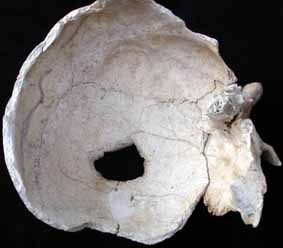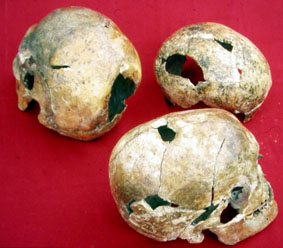
A couple of weeks ago I wrote a blog post about the Turkish discovery of a 4000-year-old scalpel made of obsidian, along with skulls that had clearly been operated on. Since then I've managed to track down the director of the excavation, Onder Bilgi, at his dig site in Ikiztepe near the Black Sea. He gave me some more information about the find and sent me some photos, so here's an update.
Bilgi told me that life in the early Bronze Age settlement of Ikiztepe was relatively sophisticated. The inhabitants lived in rectangular log houses with courtyards and ovens in front, and they were skilled in metallurgy. They mined copper in the local mountains, then alloyed it with arsenic to make weapons, tools, jewellery and religious symbols. During 37 years of excavations, Bilgi's team have found items such as loom-weights and spindle-whirls used in textile production, bone piercers, flintstone and stone tools, copper pins, small stone hand axes, and fragments of pottery bowls, jugs, jars, beakers, tea pots and pitchers.
 The researchers have also gained an insight into the spiritual life of the villagers. For example, they found a huge copper alloy spearhead, 58 centimetres long, next to a circular clay platform with a hole in the centre. Bilgi thinks this may have been a ceremonial platform and that the spearhead was used in some kind of ritual performance. Other finds include a range of abstract religious symbols, such as plaques and pendants. The plaques are decorated with spirals, or bulls' horns, while the pendants are carved into crescent or disc shapes, probably representing the Moon and the Sun, or into female figures. "It is well-known that Anatolia was the homeland of mother goddess and bull cults," says Bilgi.
The researchers have also gained an insight into the spiritual life of the villagers. For example, they found a huge copper alloy spearhead, 58 centimetres long, next to a circular clay platform with a hole in the centre. Bilgi thinks this may have been a ceremonial platform and that the spearhead was used in some kind of ritual performance. Other finds include a range of abstract religious symbols, such as plaques and pendants. The plaques are decorated with spirals, or bulls' horns, while the pendants are carved into crescent or disc shapes, probably representing the Moon and the Sun, or into female figures. "It is well-known that Anatolia was the homeland of mother goddess and bull cults," says Bilgi.
 So what about the surgery? It turns out Bilgi's team has found two scalpels, which are each about four centimetres long and double-sided (see top photo). Each is still incredibly sharp: "they would still cut you today," says Bilgi. In a graveyard on a nearby hilltop, the researchers found 700 skulls, of which 14 appear to have been operated on. A very sharp tool (Bilgi reckons obsidian would have been the only material around at the time that was sharp enough) has been used to cut rectangular openings in the skulls. Bilgi says that the surgery appears to have been done for medical reasons such as relieving a build-up of blood during a brain haemorrhage, removing a tumour, and fixing up a head injury. The skulls show signs of healing, so the patients clearly survived, at least for a few years.
So what about the surgery? It turns out Bilgi's team has found two scalpels, which are each about four centimetres long and double-sided (see top photo). Each is still incredibly sharp: "they would still cut you today," says Bilgi. In a graveyard on a nearby hilltop, the researchers found 700 skulls, of which 14 appear to have been operated on. A very sharp tool (Bilgi reckons obsidian would have been the only material around at the time that was sharp enough) has been used to cut rectangular openings in the skulls. Bilgi says that the surgery appears to have been done for medical reasons such as relieving a build-up of blood during a brain haemorrhage, removing a tumour, and fixing up a head injury. The skulls show signs of healing, so the patients clearly survived, at least for a few years.
You can read more about all this in my interview, published in this week's New Scientist.